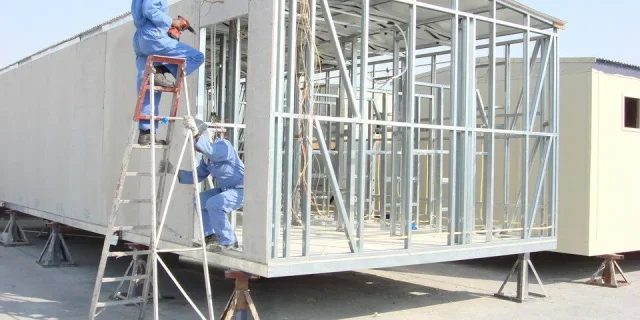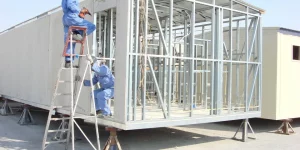Use of Light Steel in Construction – In the ever-evolving world of construction, choosing the right material is the main key to the success of a project. One material that is now increasingly popular is light steel, which offers various advantages compared to traditional materials such as wood and concrete. Although many are starting to realize the advantages of light steel, there are still many industry players who do not fully understand the potential contained in it. This article will discuss in depth about light steel, starting from the advantages to practical tips for its use.
Use of Light Steel in Construction
vmiredetstva – One unique aspect that is often overlooked in the discussion of light steel is the design flexibility it offers. Light steel is not only strong and durable, but can also be formed into various complex architectural forms. This gives architects and contractors the freedom to innovate without having to sacrifice the stability and safety of the structure being built. In addition, the use of light steel also supports environmental sustainability, thanks to a more efficient production process and the ability of this material to be recycled. This article aims to provide in-depth and practical insights into how to make the most of light steel in construction, making it the main choice for modern projects.
Advantages of Light Steel for Construction
In the context of modern construction, light steel has earned its place as the main choice, replacing traditional materials such as wood and concrete. The advantages in terms of strength, durability, and efficiency make light steel very attractive to architects, contractors, and developers. However, there are some special aspects of light steel that are rarely highlighted by experts in this field.
Strength and Durability
One of the main advantages of light steel is its high strength proportion when compared to its relatively low weight. With a superior strength-to-weight ratio, light steel is able to withstand heavy loads without the need for excessive additional supporting structures. In addition, its resistance to corrosion, fire, and pests makes it a safer and more durable choice.
Lightweight and Easy to Install
Another advantage that is often overlooked is the ease of the installation process. Its light weight makes this steel easy to transport and install, thus reducing time and labor costs. The installation process is also simpler and faster compared to traditional materials. With this flexibility, construction projects can run more efficiently, thereby reducing the risk of delays and additional costs.
Environmentally Friendly
Light steel is included in the category of environmentally friendly materials, because it can be fully recycled without reducing its quality. The production process is also more efficient in terms of energy and raw material usage compared to other materials. In addition, the use of light steel helps reduce tree felling, which contributes to forest conservation and reducing negative impacts on the ecosystem.
Cost Efficiency
In the long term, light steel offers significant cost efficiency. In addition to the relatively more affordable material price, light steel also reduces transportation and installation costs. Its durability and resistance make maintenance and repair costs much lower when compared to other materials. This makes light steel a very wise investment for construction projects.
Design Flexibility
The design flexibility offered by light steel is extraordinary, allowing architects and contractors to be more creative while still ensuring the quality and safety of the structure.
The design flexibility offered by light steel is an aspect that is often overlooked. This material can be shaped and cut according to complex architectural design needs, providing room for innovation and creativity in the construction process. This capability allows architects and designers to create unique and aesthetic structures, without sacrificing stability and safety.
By understanding these advantages, construction industry players can maximize the use of lightweight steel in each of their projects, resulting in optimal and sustainable results.
Read Also : Getting to Know Building Construction Parts Before Building a House
Types of Light Steel
Light steel is available in various types, each with different characteristics and applications. Understanding the differences between these types of lightweight steel can help construction business players choose the material that best suits their project needs. Here are some types of lightweight steel that are often used in the construction industry, complete with unique aspects that are rarely discussed:
1. Galvanized Light Steel
Galvanized light steel is a type of steel coated with zinc, providing protection from corrosion. This galvanization process provides extra resistance to weather and moisture, making it an ideal choice for projects in harsh or humid environments. This steel is known for its extraordinary durability, even in extreme conditions. Its unique advantage is its ability to maintain structural strength even when scratched or damaged on the surface, thanks to the zinc coating that can “heal” the affected area.
2. Galvalum Light Steel
Galvalum light steel, which is coated with a mixture of zinc and aluminum, offers better corrosion protection than galvanized steel. With higher resistance to oxidation and extreme temperatures, galvalum is perfect for applications that require extra protection against heat and fire. In addition, galvalum has high thermal reflectance, which contributes to reducing the heat absorbed by the building and increasing energy efficiency. In terms of visuals, galvalum also has a smoother and shinier surface, making it an attractive choice for modern architectural designs.
Read Also :Latest Women’s Top Models for Hijab
3. Cold-Rolled Light Steel
Cold-rolled light steel is formed through a cold forming process that increases strength and stability without heat treatment. This process produces steel with tighter tolerances and smoother surfaces, providing advantages in applications that require high precision. One of the unique features of cold-rolled steel is its ability to resist deformation under pressure, making it ideal for structures that require high structural integrity, such as roof and wall frames.
4. Polymer-Coated Light Steel
Another type of light steel that is increasingly popular but less discussed is polymer-coated light steel. This coating provides additional protection against corrosion and chemical damage, while enhancing aesthetics with a variety of color and texture options. Polymer-coated steel is perfect for applications that require extra durability and visual beauty, such as exterior wall panels and decorative components.
5. Hollow
Hollow light steel is generally made of galvanized material and has a block shape with square ends, and an empty inside. This material is often used for various purposes, such as roofs, canopies, and ceilings. One of the main advantages of hollow light steel is its ability to provide optimal structural strength but with minimal weight. In addition, this material is also very easy to install and cut according to project needs.

